Copyright © 2018-2024 nothrow.com. All Rights Reserved. You may not copy and distribute the content from the Site.
Football, often referred to as the beautiful game, is as much about preventing goals as it is about scoring them.
A solid defense can be the foundation of a successful team, providing stability and confidence to the rest of the squad. In the modern era of football, where tactics and strategies are evolving rapidly, understanding the best defensive formations becomes crucial.
Not only does it prevent the opposition from scoring, but it also provides a platform for the team to build attacks and maintain possession.
According to some results, teams with the best defensive records are 60% more likely to win league titles. This highlights the significance of mastering the art of defense in football.
Article Summary
- ✅ Defensive formations are the backbone of a successful football team.
- ✅ Modern football emphasizes the importance of a solid defense.
- ✅ Different formations offer unique advantages and challenges.
- ✅ Transitioning from defense to attack is a key aspect of the game.
- ✅ Expert insights can provide valuable tips for improving defensive play.
The Art of Defense: Key Principles
1. Positioning and Spatial Awareness
One of the fundamental aspects of a good defense is positioning. Players need to be aware of their surroundings, anticipate the opposition’s moves, and position themselves accordingly.
Proper positioning can cut off passing lanes, force opponents into less threatening areas, and reduce the chances of conceding goals.
According to UEFA’s coaching manual, spatial awareness is a skill that can be developed through specific drills and exercises, and it’s a trait commonly found in the best defenders in the world.
2. Communication and Teamwork
Football is a team sport, and nowhere is this more evident than in defense.
Players need to communicate constantly, alerting teammates to potential threats, organizing the defensive line, and ensuring everyone is marking an opponent.
Many experts highlighted that teams with better communication tend to concede fewer goals. It’s not just about individual brilliance; it’s about working as a cohesive unit.
3. Insights from Recent Research Studies
The article from Frontiers in Psychology study the intricacies of football match performance, specifically focusing on the defensive styles of play (1). Teams that were slow in transition or committed frequent errors were more likely to concede goals.
The research emphasizes the importance of quick transitions and minimizing errors, especially in the defensive half.
Another research article from an Institute of Sports and Sports Science and Karlsruhe Institute of Technology, studied Tactical analysis of defensive play (2).
The study’s findings, derived from the best-performing Random Forest Classifier model, highlight key tactical principles for successful defensive play.
They identified tactical principles of defensive play are related for gaining the ball:
- press the ball leading player
- create numerical superiority in areas close to the ball (press short pass options)
- compact organization of defending team
List of Popular Defensive Formations
1# 4-4-2 (Flat Four)
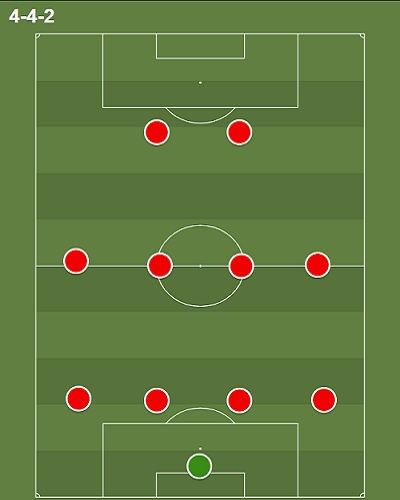
Description: The 4-4-2 is one of the most traditional and widely used formations in football. It consists of four defenders, four midfielders, and two forwards. This formation is often hailed for its balance and simplicity, making it a favorite among many managers. The two banks of four provide both defensive solidity and offensive support, allowing for quick transitions. Historically, teams using this formation have enjoyed success due to its adaptability to various playing styles.
Defensive Use: The two banks of four provide a solid defensive line, making it difficult for opponents to penetrate through the middle. The midfielders can drop back to support the defense, creating a compact unit.
Key Principles:
- Maintain a solid shape.
- Full-backs should be cautious about venturing forward.
- Central midfielders should be ready to drop deep and protect the defense.
Players Needed:
- Strong and tall center-backs.
- Full-backs with good stamina.
- Hard-working central midfielders.
- Forwards who can track back.
Pros:
- Solid defensive structure.
- Difficult for opponents to break down.
Cons:
- Can be predictable.
- Might lack width if wingers don’t push forward.
2# 5-3-2
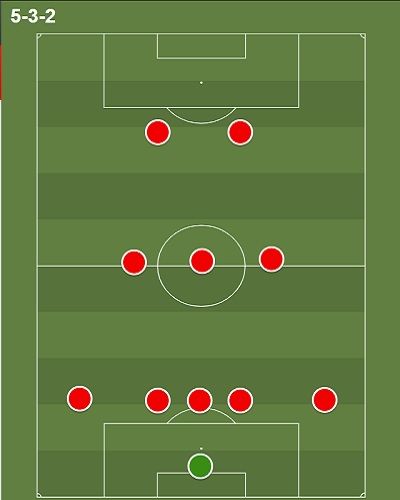
Description: This formation uses five defenders, three midfielders, and two forwards. It’s particularly defensive, with three center-backs. The 5-3-2 is perfect for teams looking to shut down the opposition and hit on the counter. The three center-backs provide an extra layer of security, making it tough for opponents to break through, especially in aerial duels. It’s a formation that demands discipline and coordination, especially from the wing-backs who play a pivotal role.
Defensive Use: The three center-backs provide extra security against teams with multiple forwards. Wing-backs can drop deep, effectively creating a back five.
Key Principles:
- Central defense solidity.
- Wing-backs provide width but must be ready to defend.
- Compact midfield.
Players Needed:
- Three strong center-backs.
- Wing-backs with high stamina.
- Central midfielders who can distribute the ball.
Pros:
- Solid against aerial threats.
- Good for counter-attacks.
Cons:
- Might lack midfield control.
- Requires very fit wing-backs.
3# 4-3-3

Description: While primarily an attacking formation, 4-3-3 can be defensive with the right tactics. It consists of four defenders, three midfielders, and three forwards. The 4-3-3 is versatile, allowing teams to press high or sit deep depending on the situation. The midfield trio is crucial for ball retention and distribution, while the wingers can stretch the play. It’s a formation that requires players to be tactically aware and positionally disciplined.
Defensive Use: The three midfielders can form a triangle, providing cover for the defense. Wingers can drop back to support.
Key Principles:
- Midfield solidity.
- Full-backs provide width.
- Forwards must track back.
Players Needed:
- Ball-winning midfielder.
- Full-backs with good crossing ability.
- Versatile wingers.
Pros:
- Balanced in attack and defense.
- Can control the midfield.
Cons:
- Vulnerable to teams with strong wingers.
- Requires forwards to defend.
4# 4-1-4-1
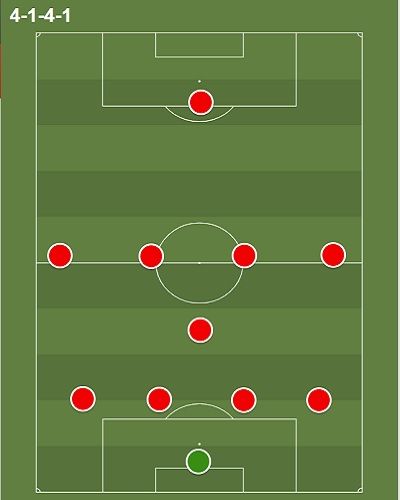
Description: This formation is a variation of 4-3-3, with a more defensive approach. It uses a defensive midfielder to shield the back four. The 4-1-4-1 emphasizes control in the midfield while ensuring defensive stability. The lone defensive midfielder acts as a pivot, breaking up play and initiating attacks. It’s a formation that requires a deep-lying playmaker with excellent vision and passing ability.
Defensive Use: The defensive midfielder breaks up opposition attacks, providing a screen for the defense.
Key Principles:
- Solidity through the middle.
- Wide midfielders track back.
- Striker offers an outlet for counter-attacks.
Players Needed:
- Strong defensive midfielder.
- Wingers with good work rate.
- Ball-playing center-backs.
Pros:
- Strong defensive shield.
- Good for counter-attacks.
Cons:
- Can be isolated in attack.
- Requires a highly skilled defensive midfielder.
5# 3-4-3
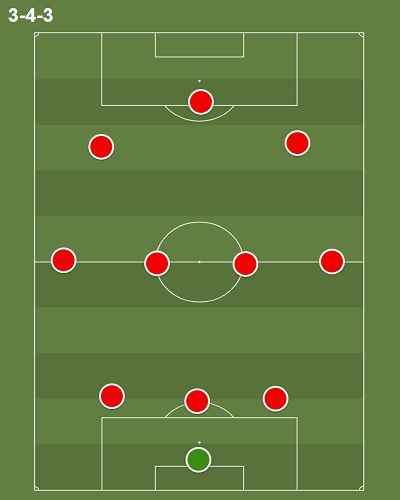
Description: A formation with three defenders, four midfielders, and three forwards. It’s flexible and can be both attacking and defensive. The 3-4-3 is dynamic, allowing fluidity in attack while maintaining a solid base at the back. The wing-backs are integral, providing width and supporting both defense and attack. This formation thrives when teams have ball-playing center-backs and dynamic midfielders.
Defensive Use: The midfield four can drop deep, effectively creating a line of seven defensive players.
Key Principles:
- Wing-backs are crucial.
- Central midfielders control the game.
- Three at the back provides security.
Players Needed:
- Ball-playing center-backs.
- Wing-backs with high stamina.
- Dynamic central midfielders.
Pros:
- Versatile.
- Solid in defense with numbers.
Cons:
- Vulnerable to teams with fast wingers.
- Requires disciplined wing-backs.
6# 4-5-1
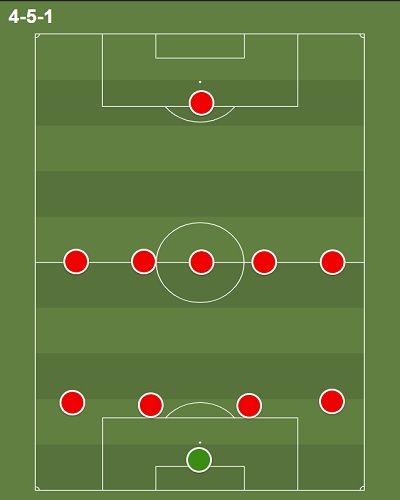
Description: A formation that prioritizes midfield control with four defenders, five midfielders, and a lone striker. The 4-5-1 is designed to congest the midfield, making it difficult for opponents to dominate the central areas. With five midfielders, teams can effectively control the tempo of the game, transitioning from defense to attack seamlessly. The lone striker must be adept at holding up the ball and bringing others into play.
Defensive Use: The five midfielders congest the middle of the park, making it hard for opponents to play through.
Key Principles:
- Midfield dominance.
- Full-backs support wingers.
- Lone striker holds up the ball.
Players Needed:
- Strong holding midfielder.
- Wingers who can cross and track back.
- Target man as a striker.
Pros:
- Great midfield control.
- Difficult for opponents to break down.
Cons:
- Can be isolated in attack.
- Requires a very mobile striker.
7# 3-5-2
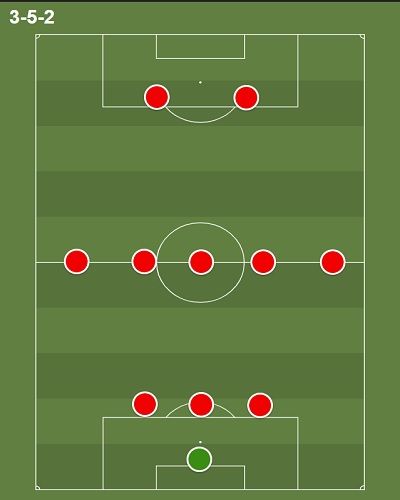
Description: The 3-5-2 formation is a versatile and dynamic setup that has been employed by numerous successful teams over the years. It consists of three central defenders, five midfielders (which includes two wing-backs), and two forwards. This formation provides a solid defensive foundation while also allowing for significant offensive firepower. The three central defenders ensure a strong presence in the heart of the defense, while the wing-backs offer width, making it adaptable to both attacking and defensive scenarios. The two forwards, often a combination of a target man and a more agile striker, can combine effectively to break down opposition defenses. The midfield trio in the center is crucial for controlling the tempo of the game, offering both defensive cover and creative output.
Defensive Use: Three center-backs provide a solid base, while the midfield five can drop deep when defending.
Key Principles:
- Central defensive trio.
- Wing-backs provide width.
- Central midfielders control the tempo.
Players Needed:
- Ball-playing center-backs.
- Dynamic wing-backs.
- Box-to-box midfielders.
Pros:
- Solid defensive base.
- Good for ball possession.
Cons:
- Vulnerable to fast wingers.
- Requires high stamina from wing-backs.
8# 4-2-3-1
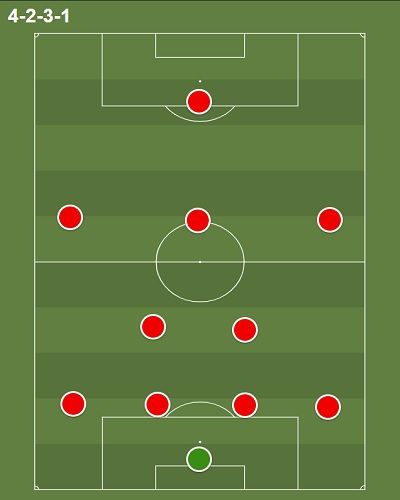
Description: A formation with four defenders, two holding midfielders, three attacking midfielders, and a lone striker. The 4-2-3-1 is a modern formation that offers balance and flexibility. The double pivot in midfield provides a solid base, allowing the attacking midfielders to express themselves. This formation is ideal for teams with a creative number 10 and wingers who can cut inside.
Defensive Use: The two holding midfielders shield the defense, breaking up play and distributing the ball.
Key Principles:
- Double pivot in midfield.
- Full-backs support the attack.
- Attacking midfielders track back.
Players Needed:
- Ball-winning midfielders.
- Creative attacking midfielders.
- Versatile striker.
Pros:
- Balanced in attack and defense.
- Two layers of midfield protection.
Cons:
- Requires highly skilled midfielders.
- Striker can be isolated.
9# 3-4-2-1
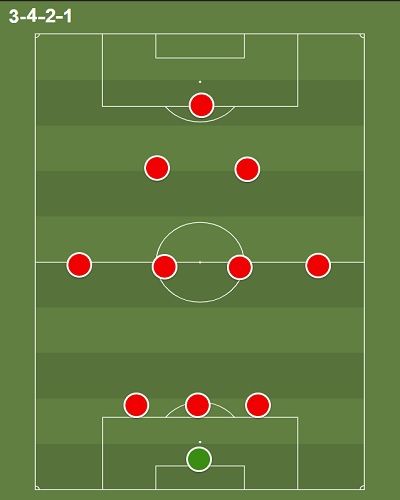
Description: A formation with three defenders, four midfielders, two attacking midfielders, and a lone striker. The 3-4-2-1 is a tactically astute formation that provides teams with defensive cover and attacking options. The two attacking midfielders can drift wide or drop deep, creating overloads and causing confusion for the opposition. The back three ensures that there’s always a numerical advantage defensively.
Defensive Use: The back three and midfield four form a solid defensive unit, while the two attacking midfielders can drop deep.
Key Principles:
- Defensive solidity with back three.
- Wing-backs are crucial.
- Attacking midfielders offer creativity.
Players Needed:
- Strong aerial center-backs.
- Wing-backs with good crossing ability.
- Dynamic attacking midfielders.
Pros:
- Solid at the back.
- Good for ball possession.
Cons:
- Requires top-quality wing-backs.
- Striker can be isolated.
10# 5-4-1
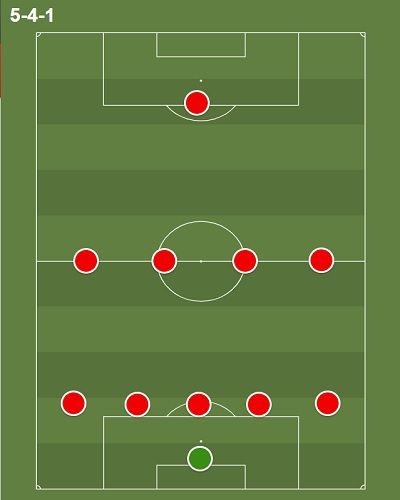
Description: An ultra-defensive formation with five defenders, four midfielders, and a lone striker. The 5-4-1 is designed for teams looking to defend deep and hit on the counter. With a five-man defense and a compact midfield, this formation is a fortress, making it extremely difficult for opponents to find spaces. The lone striker’s role is pivotal, often tasked with holding the ball and waiting for support during counter-attacks.
Defensive Use: The back five provides a solid defensive line, while the midfield four can congest the middle.
Key Principles:
- Defensive solidity is paramount.
- Midfielders track back and support.
- Striker offers a counter-attacking outlet.
Players Needed:
- Tall and strong center-backs.
- Disciplined wingers.
- Target man up front.
Pros:
- Extremely hard to break down.
- Good for holding onto leads.
Cons:
- Limited attacking options.
- Can be too defensive and invite pressure.
Expert Tips on Defensive Play
1. Training Drills for Defensive Cohesion
Former Manchester United defender and now pundit, Rio Ferdinand, emphasizes the importance of regular training drills to improve defensive cohesion (3).
Simple exercises like ‘2 vs. 2’ or ‘3 vs. 3’ can help defenders understand each other’s movements and build a solid partnership.
2. Analyzing Opponent’s Offensive Tactics
Legendary Italian defender Paolo Maldini once mentioned in an interview that understanding the opponent’s offensive tactics can give defenders an edge in anticipating moves. He added that if he needs to make a tackle, it means he has already made a mistake in positioning (4).
By studying the opposition, defenders can anticipate moves and position themselves better.
What Is My Choice?
if I had to choose a defensive formation, I would lean towards the 4-2-3-1 formation.
Here’s why:
- The 4-2-3-1 offers a balanced approach that provides both defensive solidity and offensive potential. With four defenders at the back, I can ensure a strong defensive line that can handle most attacking threats. The two defensive midfielders in front of the back four act as a shield, breaking up opposition plays and providing an additional layer of protection.
- This formation also allows for quick transitions from defense to attack. The three attacking midfielders can quickly link up with the lone striker, providing multiple options when moving forward. The wide players in the ‘3’ can stretch the play, creating spaces for the central attacking midfielder and the striker.
- Furthermore, the 4-2-3-1 is versatile. Depending on the game situation, I can easily adjust the team’s shape. If I need more defensive cover, I can ask the wide players to drop deeper, effectively turning the formation into a 4-5-1. If I’m chasing a game, I can push the full-backs higher up the pitch and ask one of the defensive midfielders to join the attack, making it more of a 4-1-4-1.
- In terms of player personnel, the 4-2-3-1 allows me to field a mix of technical and physical players. The central areas can be occupied by technically gifted players who can control the game, while the wide areas can be manned by pacey wingers or industrious wide midfielders.
In Conclusion
Mastering the art of defense in football is crucial for any team aspiring to achieve greatness. Whether it’s the classic 4-4-2 or the modern 4-2-3-1, understanding the strengths and weaknesses of each formation can provide teams with a tactical advantage.
With the right training, communication, and understanding of the opponent’s tactics, teams can build a solid defense that becomes the foundation of their success.
FAQs
Why is defense so important in football?
A solid defense provides stability to the team, prevents goals, and builds confidence among players.
How can teams improve their defensive cohesion?
Regular training drills, communication, and understanding each other’s movements can enhance defensive cohesion.
What are the advantages of the 5-3-2 formation?
The 5-3-2 formation offers a solid defensive setup, especially against teams with multiple forwards.
How do modern teams adapt their defensive tactics during a match?
Modern teams use flexible formations like the 4-2-3-1 to adapt to various situations, shifting between defense and attack.
What role do goalkeepers play in defensive formations?
Goalkeepers are the last line of defense. They organize the defense, communicate threats, and initiate attacks with their distribution.
How can teams counter fast-paced attacking teams?
Teams can use formations with additional defenders, maintain a compact shape, and focus on quick transitions to counter fast-paced opponents.
What is the significance of wing-backs in modern football?
Wing-backs provide width, support the attack, and also track back to defend, making them crucial in modern tactics.
How do teams transition from defense to attack?
Quick ball distribution, utilizing the wings, and having midfielders who can carry the ball forward are key to transitioning from defense to attack.
Are there specific drills to improve spatial awareness in defense?
Yes, drills like ‘shadow play’ and ‘positioning games’ can enhance spatial awareness among defenders.
How do top teams maintain defensive discipline during high-pressure situations?
Communication, experience, and understanding of the game plan are essential for maintaining defensive discipline during high-pressure moments.
Give us feedback: Was his article helpful?

Comments are closed.